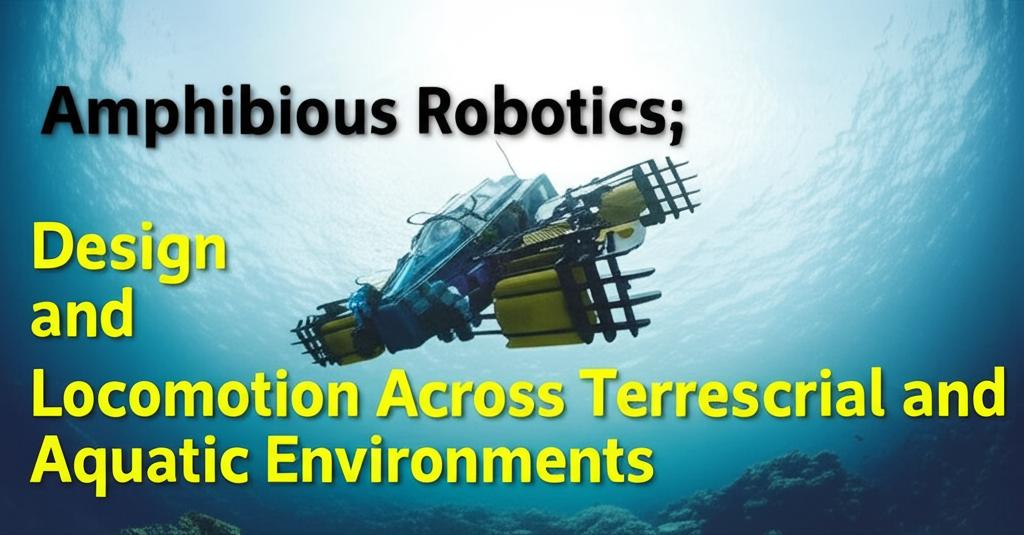Amphibious robots, designed to operate in both terrestrial and aquatic environments, represent a rapidly advancing field in robotics. These robots offer versatile locomotion and maneuverability across diverse terrains, making them crucial for applications like reconnaissance, surveying, environmental monitoring, and search and rescue operations.
Design Principles and Challenges
The core challenge in amphibious robot design lies in creating effective propulsion mechanisms for both land and water. Engineers must balance conflicting features, as shapes conducive to load-bearing and land maneuverability often detract from hydrodynamic efficiency. The transition zone between water and land, known as the littoral zone, presents further obstacles due to turbulence, mixed substrates, and physical barriers.
Key Design Considerations:- Waterproofing: Essential for protecting internal components from water damage.
- Buoyancy Control: Enables the robot to float or submerge as needed for efficient movement in water.
- Propulsion Systems: These vary widely and can include wheels, tracks, legs, propellers, fins, or undulating bodies. The choice depends on the intended application and desired performance characteristics in each environment.
- Sensors: Necessary for navigation, obstacle detection, and environmental sensing in both air and water.
- Material Selection: Materials must be durable, corrosion-resistant, and suitable for the stresses of both land and water operation.
Locomotion Strategies
Amphibious robots can be broadly categorized by their locomotion mechanisms:
- Wheeled Robots: Often use the same wheels for land and surface water travel. While this simplifies control, it can limit speed in water due to drag. Some designs incorporate paddles or transformable wheels/propellers to improve aquatic performance. Wheeled robots generally offer high mobility on smooth surfaces.
- Legged Robots: Inspired by animals like salamanders, cockroaches, or crabs, legged robots offer adaptability to uneven terrain and obstacles. They can use various gaits for land and may employ their legs for paddling or walking on the seabed. While versatile, their speed might be slower compared to other types. Recent developments include robots with implicit control, where the robot's body and its interaction with the environment are seen as components to achieve control, rather than disturbances to overcome. This allows for smoother transitions without needing to explicitly estimate the environment.
- Undulating Robots: These robots, often inspired by snakes or eels, use body undulations for propulsion in both water and on land. They can be highly flexible and navigate complex pathways, though controlling multiple segments can be challenging.
- Hybrid Mechanisms: Many amphibious robots utilize hybrid designs, combining different propulsion methods. These can be:
Separate Propulsive Mechanisms: Distinct systems for land and water (e.g., wheels for land, propellers for water). This allows for specialized and potentially more efficient locomotion in each domain but can increase complexity.
United Propulsive Mechanisms: The same system is used for both environments (e.g., transforming limbs, specialized wheels that also act as paddles). This can reduce complexity but may involve performance compromises in one or both domains. Examples include rocker-bogie mechanisms with paddle-wheels, or robots with transformable flipper-leg composite propulsion.
- Soft Robots: Emerging soft amphibious robots offer unique advantages in adaptability and navigating unstructured environments. Some soft robots can achieve multimodal locomotion, including jumping on both land and water.
Bio-inspiration
Nature provides a rich source of inspiration for amphibious robot design. Researchers study animals like turtles, salamanders, snakes, and insects to understand how they efficiently move between and within different environments.
- Salamander-inspired robots: These often feature articulated bodies and limbs, mimicking the walking and swimming gaits of salamanders. Some models use central pattern generators (CPGs) – neural circuits that generate rhythmic movements – to control locomotion.
- Turtle-inspired robots: Designs may feature morphing limbs that can change shape and stiffness, transitioning from a streamlined flipper for swimming to a robust leg for land-based movement. This approach aims to optimize performance in each environment by adapting the limb's morphology.
- Fish-inspired robots: Some designs incorporate fish-like body oscillations for swimming and may use wheeled or legged mechanisms for land.
- Modular Designs: Some robots are designed with a modular approach, allowing for disassembly and replacement of parts, and potentially combining different modules (e.g., a floating robot system with a crawler chassis).
Transitioning Between Environments
A critical capability for amphibious robots is the seamless transition between terrestrial and aquatic environments. This phase often involves navigating challenging terrains like sandy beaches, muddy banks, or rocky shores. Robots need robust propulsion and adaptable maneuvering strategies to overcome these obstacles. Some designs focus on:
- Hybrid wheel/propeller mechanisms: These allow for forward thrust in water and wheeled motion on land by reorienting the propulsive elements.
- Transformable limbs: Limbs that can change shape or stiffness to suit either swimming or walking.
- Track-based systems with fins: Using tracks for land and undulating fins for underwater movement, sometimes driven simultaneously to avoid mode switching.
Recent Advancements and Future Directions
The field of amphibious robotics is continually evolving, with recent advancements focusing on:
- Improved Efficiency and Speed: Enhancing locomotion performance in both environments.
- Greater Adaptability: Developing robots that can better handle unstructured and unpredictable terrains, including the challenging littoral zone.
- Sophisticated Control Systems: Implementing advanced control algorithms, including those based on implicit control or AI, to enable more autonomous and adaptive behavior.
- Miniaturization and Soft Robotics: Creating smaller, more flexible robots capable of tasks in confined spaces or delicate interactions. Origami-inspired robots with body sensing for multimodal locomotion are an example of this trend.
- Enhanced Sensory Capabilities: Integrating a wider array of sensors for better environmental perception and navigation.
- Modular and Reconfigurable Robots: Designing robots that can adapt their form or function for different tasks or environments.
The continued development of amphibious robots holds significant promise for a wide range of applications, from scientific exploration and environmental monitoring to disaster response and defense. Overcoming the inherent design challenges by drawing inspiration from nature and leveraging new technologies will be key to realizing their full potential.

